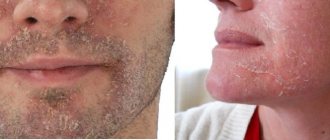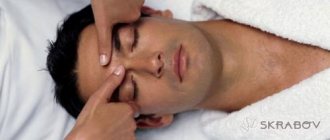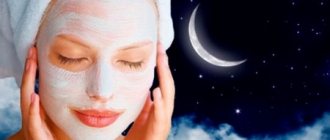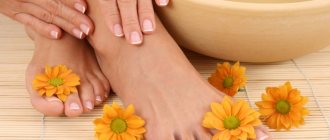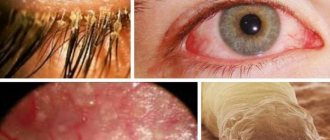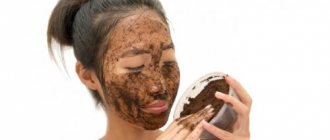Signs and origins of oily facial skin
Oily skin is the result of overproduction of oil by the sebaceous glands. These glands are located under the surface of the skin.
Sebum is a substance made up of fats. It's not too bad as it protects and moisturizes the skin and keeps the hair on your head shiny and healthy.
Too much sebum, however, can lead to oily skin, which can lead to clogged pores and acne.
The occurrence of comedones (blackheads), fatty gland cysts, and seborrhea is also not uncommon. The skin is similar to an orange peel because it has pores.
An undeniable advantage for people with oily skin is that wrinkles begin to appear later.
The epidermis shiny from grease is an unpleasant phenomenon for its owners. Due to the excessive work of the fat glands, a rough, porous texture with an unhealthy tone and a greasy sheen is formed on the skin; the surface of the skin can be overdried, like parchment.
Genetics, hormonal changes, or even stress can increase sebum production.
Oily tissue on the face is localized in the T-zone: forehead, chin and nose. On the body, the greasy epidermis is located on the back and chest. The properties of oily skin also appear on oily hair on the head.
This happens for the following reasons:
- Genetically determined. Under these circumstances, the epidermis is oily throughout life.
- Adolescence. Teenagers are familiar with the manifestations of oily skin, which by the age of 25-30 becomes combination.
- Intensive work of fat glands. This is associated with an inherited predisposition to oily skin, disrupted processes in the gastrointestinal tract (cholecystitis, colitis, constipation), and hormonal changes. The reason for the excessive production of fat on the skin surface is diet (addiction to spicy, fatty, starchy foods, alcohol, soda), work at elevated temperatures, being in a room smoked by cigarettes, under UV radiation.
- Hormonal. This happens during puberty and the 2nd phase of the menstrual cycle. Hormonal disruption occurs during menopause, pregnancy, and stress. This also occurs due to treatment with hormones or their sudden use, or prolonged use of oral contraceptives.
- Disorders in the functioning of the endocrine system. This occurs when, with hypothyroidism, both dry skin and oily epidermis on the face are noted.
Reduced immunity also affects the appearance of the sebaceous surface of the epidermis.
The fifth rule is the application of skincare products
Oily skin, which constantly develops shine, needs hydration and nutrition, which must come from external sources. This source can be a water-based moisturizer. It should be applied immediately after cleansing and other procedures. After 5-10 minutes, you can wipe your face with a paper towel to remove any unabsorbed product residue.
Green pharmacy (5 healing herbs)
How to get rid of the problem at home? It is advisable to treat sebaceous skin with herbaceous plants.
The presence of flavonoids, tannins, saponins (nitrogen-free and alkali-free organic natural substances), silicic acid, plant hormones and microelements have a positive effect on the sebaceous epidermis.
- Chamomile is a natural antiseptic with anti-inflammatory effect. Its extract can cleanse and soften the skin surface of the face, restore elasticity and smoothness.
- Salvia officinalis has bactericidal, soothing, regenerating powers. Calendula officinalis has the ability to heal and restore damaged epidermis.
- Oak (birch) bark is famous for its antiseptic and tanning qualities. Tricolor violet extract is aimed at cleansing, stimulating metabolic processes and ridding the body of harmful substances.
- Green tea extract has the role of an antioxidant, which reduces the effect of free radicals on the skin.
- An extract from dandelion root increases the body's protective forces, helps in the functioning of the liver, gall bladder, and kidneys. The plant extract is involved in releasing the body from metabolic products, which has a positive effect on the surface of the skin.
Each patient selects an herb that is effective on the oily dermis individually. Replace water when washing with herbal infusions of chamomile, mint, nettle, and linden blossom.
We use masks
To get rid of oily shine on the forehead, cosmetologists recommend making simple face masks at home about two or three times a week. These masks are very easy to make and do not require the purchase of overly expensive products.
Curd mask
Rub 20 grams of cottage cheese through a sieve.
Add 30 ml of low-fat kefir to the cottage cheese.
Add a couple of drops of peppermint essential oil, although you can do without this ingredient if you wish.
Mix well and apply to previously cleansed face. Leave for 30 minutes and rinse with cool water.
Blue clay mask
Grind one tablet of brewer's yeast.
Add blue clay to them in the amount of one large spoon.
Pour in brewed green tea and stir. The consistency of the mass should resemble sour cream.
Apply to steamed skin if there are no acne, let dry and rinse with cool water.
Pea mask
Grind the dried green nuts in a coffee grinder.
Add 2 grams of turmeric.
Add 8 drops of peach oil.
Mix everything and apply to a previously cleansed face. Wait 30 minutes and rinse with water.
Mask with aspirin
Crush 2 tablets of acetylsalicylic acid.
Add mango essential oil 4 drops.
Pour in the plantain decoction to achieve the consistency of sour cream.
Apply to face only with a brush or do it with gloves. Wait 10 minutes and rinse with warm water.
Basic rules for applying masks
If your forehead and nose are oily, and sometimes even very oily, then these masks will help cope with this unpleasant phenomenon. But before you start the procedure, you need to remember a few rules.
- Be sure to wash your hands.
- Use only fresh ingredients for masks.
- Before applying, be sure to wash your face using one of the products listed above.
- Do not use components that contain alcohol.
- Under no circumstances leave any leftover mask for next time.
After the mask is washed off, the skin should dry on its own. And after that you can apply cream on it. The best option is a face cream with aloe, which helps prevent inflammation, relieves irritation and redness, and gets rid of small pimples.
Oils for oily skin
Oil formulations are used instead of night cream. They are applied in a thin layer to a clean skin surface.
Oils act on pores clogged with dirt and hard fat, regulate sebum production, and affect cell regeneration.
Which oils to use? Here is their list:
- Hazelnut in pure form or as part of other oils. Under the influence of the product, the surface of the skin is cleansed, smoothed and restored, the pores are tightened.
- Grape seeds, after which the surface of the dermis looks moisturized and without noticeable pores.
- Berries, buds, black currant leaves - the product is endowed with antibacterial properties, the skin after it becomes elastic, the tone increases.
- Sesame seeds, which influence the normalization of the functioning of the sebaceous glands, narrowing of pores.
- Almond kernels, which cope with cleaning pores and irritation of red spots.
- Tea tree leaves - oily composition saves from acne and normalizes the condition of the dermis.
- Lavender restores dullness to the skin and has an anti-inflammatory effect on the dermis.
Use hazelnut oil (50% of mixing) with the addition of 10% of other selected oils. If you take essential oils (from sandalwood, rosemary, juniper, bergamot, grapefruit, cedar), add 1-2 drops to the base oil composition.
The fourth rule is vaporization
Steaming your facial skin, which should be done once or twice a week, will effectively cleanse it, improve blood circulation, and stimulate metabolic and regenerative processes. Vaporization should not be done frequently, so as not to once again activate the activity of the sebaceous glands, which are sensitive to increases in external temperature.
To steam, use one of two methods:
- Prepare hot water that produces steam. This can be regular drinking water or a water infusion/decoction of chamomile or any medicinal herb. Cover your head with a towel, lean over the container with liquid, but do not bring your face close to the surface of the water so as not to get burned by very hot steam. This steam “bath” should be taken for 5-7 minutes.
- Prepare hot but not scalding water or a decoction of medicinal plants. Soak a small hand towel in the liquid; it is better if it is terry, as it will retain more moisture. Wring out the towel so that no water drips from it, place it on your face and lie down for 10-15 minutes until the fabric has cooled.
- After vaporization, you can wash your face with foam to remove the remains of dead cells and impurities. It is not recommended to go outside after the procedure (at least for 1-2 hours), especially in the cold season.
Before steaming your face, it is recommended to consult a doctor or cosmetologist, as you may have contraindications to the thermal procedure. For example, diseases of the cardiovascular system.
Cosmetic treatments for oily skin
What to do if your skin is oily and acne appears? To eliminate the problem of oily skin, it is permissible to include the following measures:
- using scrubs (from almond, apricot, salt, clay, etc.), this will even out and cleanse the skin;
- the use of peelings with acids (lactic, fruit, pyruvic, trichloroacetic, glycolic, etc.), this will reduce pH, regulate sebum production and reduce the fat content of the dermis;
- consumption of masks (mud, clay, seaweed based), and this will disinfect, soothe the skin surface and remove excess fatty deposits.
It is recommended to contact a cosmetologist in a specialized center to carry out professional cleansing of the epidermis.
Salon treatments
Very oily skin requires special treatment. After a mandatory consultation with a dermatologist and cosmetologist, you can try hardware procedures. Laser biostimulation helps well: a laser acts on the skin, causing photochemical changes in the epidermis. After such a salon procedure, the skin becomes renewed, more elastic, and its color improves.
Read also: Diagnosis of perioral dermatitis
For enlarged pores and wrinkle removal, you can try microdermabrasion. During this procedure, the skin is painlessly polished with a stream of tiny particles, such as diamond chips or aluminum oxide.
To prevent clogging of hair follicles with fat and to reduce purulent rashes on the skin, ultraphoresis is used. And ultrasonic cavitation peeling cleanses the face using ultrasound, removes excess sebum from the pores and keratinized epidermis.
Very oily skin on the face can also be treated using such an effective procedure as darsonvalization. Using vacuum electrodes, a high-frequency pulsed current is applied to the face. This procedure dries the skin, regenerates epidermal tissue and improves their nutrition.
In beauty salons you can also do mechanical facial cleansing. In order not to injure the epidermis, it should only be performed by a specialist. Peels using fruit, lactic, glycolic or trichloroacetic acid also help. After peeling, the pH of the skin decreases and greasiness is significantly reduced. You can also cleanse your facial skin and smooth its surface using an apricot, almond or clay scrub. After the procedure, the cosmetologist advises how to care for your face at home and sets a time for the next procedure.
Question answer
Of course, oily skin also needs regular moisturizing. With this type of skin, fat interferes with normal cell respiration, pores become clogged, and even collagen production deteriorates. This is why it is important to cleanse the skin surface and then remember to moisturize it.
To do this, you can use special special napkins. They gently wipe the face, which removes excess sebum without spoiling the makeup. It is also worth carrying powder with you, which after a while can hide the flaw.
This is explained by the fact that after using a paper towel, a person immediately throws it away. But the towel often remains too wet, and this is an ideal environment for bacteria to multiply. As a result, they end up on the skin surface, which, especially on oily skin, can lead to inflammation.
conclusions
- A timely visit to a specialist and the choice of appropriate treatment will prevent the transition of mild acne to acute seborrheic dermatitis.
- Give preference to cosmetic, decorative and care products with antiseptic and anti-inflammatory properties. For example, such as creams for problem skin.
- Don't forget to cleanse, tone and moisturize oily facial skin twice a day.
- Choose cosmetics that do not contain alcohol, mineral oils or other comedogenic substances that cause acne.
All about steaming face masks for use before cleansing.
TOP 5 treatment methods
Skin with excess oil content that is prone to peeling requires additional treatment prescribed by a dermatologist or cosmetologist.
The course of treatment is determined by a specialist after receiving the results of a blood test (glucose, hormones), familiarization with hereditary predispositions, medical history, etc.
The skin surface can be cured of oiliness using hardware measures:
- Laser biostimulation. The beam induces photochemical transformations in the dermis. During the sessions, the epidermis is smoothed, renewed and regenerated. Its elasticity and tone change for the better.
- Microdermabrasion of the dermis. Based on the action of an abundance of microscopic particles. They will polish the skin without pain, eliminate wrinkles, tighten pores, and reduce stretch marks.
- Iontophoresis. It acts on the sebaceous dermis with microcurrents. As a result, blood flow to it, nutrition and microcirculation improves. The treatment restores the skin surface due to deep diffusion of nutrients and eliminates oiliness.
- Cavitation (ultrasonic) peeling. With a shock wave, it cleanses the skin without pain, removes excess sebum from the pores of the hair follicles, and cleanses the keratinized dermis.
- Ultrasonic phonophoresis. Based on mechanical vibrations. The procedure achieves massage, destruction of fibrous tissue, lymphatic drainage (removal of excess fluid). The technique prevents oil from clogging the hair follicles and reduces skin rashes and irritation on the dermis.
Darsonvalization with pulsed high-frequency current affects the skin with vacuum electrodes. As a result, the skin dries out, nutrition and tissue restoration are enhanced.
The doctor decides at the appointment which method of treating oily dermis is suitable for a particular patient.
Problems with makeup
If you are prone to oily shine, you must take this fact into account in your daily care and makeup.
If the sebaceous glands are overworked, you need to replace the care with a lighter one, choose creams that are soft in texture, and replace them with serums or emulsions. In difficult cases, the Japanese system of nourishing lotions may be suitable.
Using soft scrubs and light peelings will refresh the skin, make it denser, and tighten the pores. Makeup turns out to be short-lived and fades. When choosing cosmetics, you need to choose special products that are suitable for the type.
- The makeup base should be mattifying - this is a guarantee of durability;
- the foundation should contain clay to control oiliness and zinc oxide, be matte,
- dense, with a note about skin type;
- blush, like powder, should be dry and matte; liquid products are not suitable;
- The ideal choice is mineral cosmetics without fats, preservatives and other products that overload the skin.
Decorative cosmetics contain particles that imitate natural radiance. Highlighters and shimmers, if applied incorrectly, can create an artificially oily shine. If your skin type is combination or oily, or the environment is very hot, these products enhance the effect of oily shine; it is better to avoid them in favor of mattifying products.
Attention! When caring for a face prone to excessive shine, it is important to choose low-fat skincare cosmetics designed for two uses per day. Morning and evening care with lotions, gels, emulsions and serums will nourish the face with the necessary substances and calm the glands. Denying skin care products means stimulating it to produce an oily film.
Expert opinion
- Cosmetologist
- Surgeon
Anna Avaliani
practicing cosmetologist
Reducing the consumption of fats in food will not change the situation much. Be sure to use special products when washing your face; water simply cannot thoroughly cleanse the skin. But do not overdo it, as this can lead to excessive degreasing or drying out.
Aisha Baron
plastic surgeon
To wash your face, use gels, foams suitable for your skin type, and cold water.
Use toners, and moisturize your skin with cream before applying cosmetics. I also recommend not to forget about sunscreen. Cleanse your skin daily in the evening to remove dirt and makeup. And apply the cream again, only at night. These are simple rules, but they will help maintain the beauty of your skin. Proper care and a healthy lifestyle will eliminate excess oily skin. It makes the surface of the dermis attractive, eliminates acne and greasy shine. At the same time, it is not difficult to maintain the visual youth of the face.
To do this, you should follow simple rules and take care of your skin. If you cannot solve the problem of excess fat on your own, you should consult a doctor.
Eighth rule - emergency measures
If the need to remove oily shine from your face often catches you at the most unexpected moment, keep in mind these ways to quickly correct the situation:
- Using matting wipes.
You just need to apply such a napkin to the problem area, and the skin will become matte again, since the special fabric will absorb excess secretions from the sebaceous glands. However, this method, which helps remove oily shine from the face, is suitable only for those girls and women who do not use decorative cosmetics (foundation, powder). If you have makeup on your face, it will smudge and be partially absorbed into the fabric when using the napkin.
- Universal refresher - thermal water in a spray bottle
. The liquid will instantly moisturize and refresh the skin, eliminate oily shine, even if applied over makeup.
- Oatmeal powder
. If you use regular powder, the oily shine will disappear instantly and your face will become matte. But the situation with the skin will get worse. The use of mineral powder will not harm the skin and will not cause clogging of pores. But high-quality mineral products are expensive. What to do if you don’t have money right now, but you don’t want to tolerate the oily shine on your face? Make your own powder! To do this, you only need a coffee grinder and a few spoons of regular oatmeal. Place oatmeal in the container of the kitchen appliance and begin the grinding process. After a few minutes, fine powder, almost oatmeal dust, will collect on the inner surface of the coffee grinder lid. Collect it in a cleaned jar of used powder and apply to your face as needed. The advantage of oatmeal powder is that it has a suitable shade for fair skin. If you have dark skin, try making buckwheat powder as described above.
Rules of care
Firstly, it is worth reviewing your diet and limiting as much as possible the consumption of foods that provoke excessive work of the sebaceous glands: flour, excessively sweet, spicy, fried in oil, etc.
Try to touch your face with your hands less often, even if you have washed them. Bacteria from your hands, with which you touch everything, as if across a bridge, quickly run over to your face. It's better not to give them such a chance.
Also, do not overdo it with decorative cosmetics, do not wear makeup for a long time, and in the evening carefully remove all excess makeup.
Night care
Using a night cream will help your skin for the simple reason that resting at night is the time when the components of the product work most effectively, because nothing outside distracts it.
The processes of restoring the lipid-water balance of the skin are especially active at night. So the first thing you should do is ensure that you get a good rest at night.
Therefore, at the end of the day, cleanse your skin and apply cream before settling into a restful and sound sleep. Suitable night cream: Natura siberica, Vichy, Diademine, etc.
Day care
After waking up, cleanse your skin again: excess cream and oil produced overnight can clog your pores. Let your skin “enjoy the new day”, let it breathe and refresh itself.
Do not wash your face with hot water: this can cause the sebaceous glands to become more active. Another tip: don't wipe your face with a towel. You never know what's on its surface. As we have already said: once again, do not touch your face, not only with your hands, but with everything in general, and do not lean your face against anything.
Care after 25 years
At this age, women think little about what will happen to their skin, let alone in old age - even after five to ten years. In fact, it’s worth taking care of your skin condition early. As they say, take care of your dress again - and your skin from a young age.
Therefore, daily care is enough for the skin. Healthy sleep, proper nutrition, proper use of cosmetics - at a time when the skin is young and does not require collagen replenishment and special care, as for aging skin. Basic methods will deal with the problem best.
However, consultation with a dermatologist is still required. To know for sure that there are no diseases whose symptoms are acne and oily sheen.
Care after 30 years
Caring for problematic facial skin over the age of 30 years has its own characteristics. At this age, problems such as frequent inflammation, lack of moisture, and increased sensitivity begin. When choosing a treatment strategy, you need to remember some simple rules:
Pay special attention to sun protection: sunlight ages faster, and in general does not have the best effect on the skin. Use a cream with a high SPF, especially during the hot season.
Care after 40 years
As old age approaches, special care is required. But in addition to general recommendations, start following age-related care. The time for excess sebum production is over. You need to focus more on careful care to prevent and eliminate age-related changes. Compliance with the regime is now several times more important than in youth, when, after the influence of many stress-forming factors, you and your skin could easily look great. Choose your care products wisely and monitor your health even more closely.
Winter care
In winter, the skin suffers from the icy wind and flakes due to the frosty air, which has almost no moisture. Care at this time requires additional hydration so as not to provoke additional inflammation. Therefore, choose denser creams that protect and nourish all layers of the epidermis.
Do not use products based on mineral oils, which provide good moisturization only for a short time, as over time they destroy the skin's protective barrier.
If regular cleansers cause a feeling of dryness and tightness, replace them with more gentle ones for sensitive skin. Make sure that the skin does not get too cold, as this can only worsen the unpleasant symptoms.
Summer care
Sun, heat, swimming – beauty! For some reason, it is believed that in the summer, this type of skin causes fewer problems, because the sun's rays dry out the skin. As it turns out in fact, increased sebum secretion can also intensify due to high temperatures, active sunlight, increased sweating and dust.
In summer, the skin needs thorough cleansing of adhering dirt, excess sebum mixed with sweat. Use less makeup, because it clogs pores and provokes inflammation and rashes. In particular, reduce your use of foundation.
Konnyaku sponge
Korean care
South Korea is famous throughout the world for its skin care products. The Koreans have reached incredible heights in this field, and now we will follow their example.
For example, the famous “424” washing system, which includes three stages. But we will take a closer look at the care products known around the world:
- Konjac Sponge: It contains the root of the konjac plant, which has many beneficial natural properties. Of all those provided, this remedy is the most delicate.
- Cellulose sponge: when used, the skin undergoes additional polishing, the entire top layer is cleaned, and it becomes smooth and velvety. It poses no risk of injury.
- Mechanical brushes. They have many thousands of small villi, which are so thin and delicate that they penetrate the pores and clean them of dirt, prevent the appearance of blackheads, and clean out the keratinized layers. (eg DE. CO). Just be careful. This product is not suitable for everyday use, but it is quite suitable as a deep and radical cleanser.
Cosmetological methods for getting rid of oily skin
- Acid or ultrasonic peeling normalizes the functioning of the glands, tightens pores, refreshes color, and eliminates unevenness and blemishes.
- Darsonvalization exposes the face to high frequency currents. This effect reduces fat content, improves nutrition from the inside, and triggers regeneration. The need for active work of the sebaceous glands disappears, dullness and velvety return.
- Ultrasonic phonophoresis. Mechanical vibrations have a massage effect and bring excess fat and moisture to the surface.
- Cryotherapy is exposure to cold. Exposure to low temperatures stimulates blood vessels to constrict and dilate. Blood circulation improves, renewal processes are launched. In addition to getting rid of shine, almost all problems are solved: wrinkles are reduced, color is evened out.
Remedies for oily face
Matting napkins are thin sheets of translucent paper that absorb excess oil like a blotter.
You can use it even with makeup applied - the wipes instantly improve your appearance without destroying the layer of decorative cosmetics.
Liquid cleansers - micellar or cosmetic water in the form of a spray. Spraying with this product does not spoil makeup: the droplets are small, like steam. The product dissolves fat without leaving any residue. After 15 minutes, the moisture dries completely, you only need to touch up your makeup if necessary.
Mattifying makeup bases are Photoshop without a computer: they even out the skin, making it matte and well-groomed. The products are applied after skincare cosmetics. By the way, it is not necessary to apply decorative makeup!
Powder is an instant way to get rid of shine. The effect of loose powder is stronger than that of compacts. Brushes should be washed from time to time with a special brush cleaner or a drop of regular shampoo. For areas of increased fat content, use a light tone; tan shades can get lost and look like sloppy spots.

